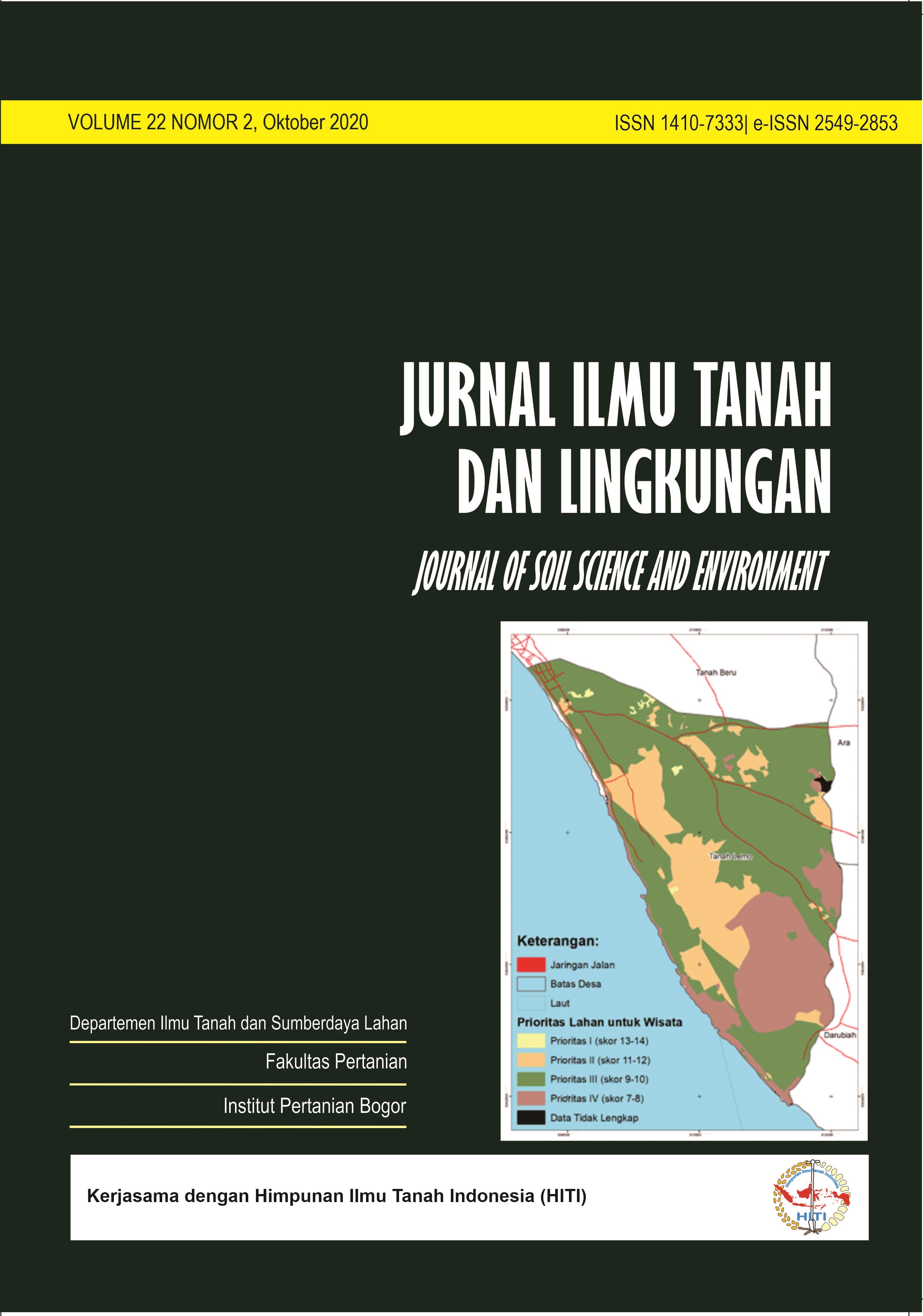Impact of Pesticide Residues on the Diversity of Soil Fungi on Vegetable Land
Dampak Residu Pestisida Terhadap Keanekaragaman Jamur Tanah Pada Lahan Sayuran
Abstract
Insecticides have a negative effect on soil fungi because they contain dangerous toxic compounds. The use of insecticides by Noelbaki village farmers in vegetable cultivation is quite intensive with, a frequency of 2-3 spraying per week. The application of this insecticide is carried out continuously during the planting of vegetables so that it has a negative impact on the soil environment. This study aimed to determine the content of insecticide residues and the diversity of soil fungi in mustard vegetable fields. The research method used was a survey method conducted on several mustard vegetable farmers by collecting information using a questionnaire as a means of collection data and laboratory tests of residue content in the soil. Soil samples were taken using a diagonal pattern with 5 replications on mustard greens on Vertisols and Inceptisols both applied and without insecticides. Soil samples in a composite soil were carried out for the analysis of residual content and physical and chemical properties of the soil, while not composist was used for the observation of soil fungi. The variables observed were the content of insecticide residues, population density, diversity and frequency of presence, soil fungi and the physical and chemical properties of soil on the vegetable land. Analysis of insecticide residues was carried out using the Gas Chromatography-Spectrometry Mass (GC-MS/ MS) method, and the counting of microbes was carried out using the Plate Counting Agar (PCA) method, while the identification of microbes was carried out by microscopic and macroscopic observations. Insecticide residues with the active ingredient Lamda-cihalotrin in the Vertisol type soil samples treated with insecticides were 0.060 ppm, and in the Inceptisol soil samples with the active ingredient Dimetoat as much as 0.042 ppm. The density of soil mushroom population was higher in vegetable fields without the application of Insecticides as much as 71.6 CFU g-1, the value of soil mushroom diversity index was higher in insecticide application vegetable fields 1.609, the frequency of presence of the fungus species Penicillium constant 100% and Mucor 90%.
Downloads
References
AOAC [Association of Official Analytical Chemists]. 2007. Pesticide residues in foods by acetonitrile extraction and partitioning with magnesium sulfate. AOAC INTERNATIONAL.
Brandy, N.C. and R.R. Weil. 2002. The nature and properties of soil. Prentice hall, Upper Saddle River, New Jersey.
Binhui, J., Y. Chanqi, W. Hengpeng, G. Kunyu, L. Bin, J. Li, H. Rui and P. Wei. 2011. Study on relationship between microbial diversity and organophosphate pesticide residues in planting base soils of shenyang. Intelligent Computation Technology and Automation, International Conference.
Campbell, R. and J.M. Ephgrave. 1993. Effect of bentonite clay on the growth of gwumunnumyces gramhis var. tritici and its interactions with antagonistic bacteria. Journal of General Microbiology, 129: 771-777.
Djojosumarto, P. 2008. Pestisida dan Aplikasinya. Agromedia Pustaka, Jakarta.
Ellouze, W., A.M. Taheri, L.D. Bainard, C. Yang, N. Bazghaleh, A.N. Borrell, K. Hanson and C. Hamel. 2014. Soil fungal resources in annual cropping systems and their potential for management. BioMed Research International, 2014 (2014). Article ID 531824.
Ghany-Abd El, T.M dan I.A. Masmali. 2016. Fungal biodegradation of organophosphorus insecticides and their impact on soil microbial population. Journal of Plant Pathology and Microbiology, 7(5): 349-355. doi:10.4172/2157-7471.1000349.
Handayanto, E. dan K. Hairiah. 2009. Biologi tanah. Landasan Pegelolaan Tanah Sehat. Adipura, Yogyakarta.
Hanafiah, K.A. 2014. Dasar-Dasar Ilmu Tanah. Divisi Buku Perguruan Tinggi. Raja Grafindo Persada, Jakarta
Jackson, T.A. 1995. Effect of clay mineral, oxhydroxides, and humic matter on microbial communities of soils, sediment, and water. P. 165-200. In P. M. Huang, J. Berthelin, J. M. Bollag, W. B. Mc Gilli. A. L. Page (Eds.) Envinonmental impact of Soil Component interactions. Metals, other Inorganics, an Microbial Activities. CRC Lewis Publication, Boca Raton.
Jatmiko, S.Y., E. Martono, D. Prajitno dan S. Worosuprojo. 2010. Distribusi ruang insektisida heptaklor di lahan pertanian Kabupaten Bantul Provinsi Daerah Istimewa Yogyakarta. Jurnal Perlindungan Tanaman Indonesia, 16(1): 47–54.
Kurniawati S., Zarsito and Noegrohati. 2010. Deltamethrin dynamics in soils from Daerah Istimewa Yogyakarta Province. The 2nd International Conference Chemical Sciences Proseeding.
Mella, W.I.I. 2003. Genesis an mineralogy of alfisols and mollisols on raised coral reef in west Timor Indonesia [Thesis]. University of Saskachewan, Saskatoon, Canada.
Murugan, A.V., T.P. Swarman and S. Gnanasambadan. 2013. Status and effect of pesticide residues in soils under different land uses of Andaman Islands, India. Environ. Monit. Assess., 185(10): 8135–8145. https://doi.org/10.1007/s10661-013-3162-y.
Nahas, E.A. 2013. Perilaku petani sayur dalam penggunaan pestisida kimiawi (studi kasus di Desa Mata Air dan Kelurahan Tarus, Kecamatan Kupang Tengah, Kabupaten Kupang [Tesis]. Ilmu Lingkungan Universitas Nusa Cendana, Kupang.
Narwanti, I., E. Sugiharto dan C. Anwar. 2013. Residu pestisida piretroid pada bawang merah di Desa Srigading, Kecamatan Sanden Kabupaten Bantul. Jurnal Ilmiah Kefarmasian, 2(2): 119-128.
Nasution, R.M., T. Sabrina dan Fauzi. 2014. Pemanfaatan jamur pelarut fosfat dan mikoriza untuk meningkatkan ketersediaan dan serapan p tanaman jagung pada tanah alkalin. Jurnal Agroteknologi, 2(3): 1003-100.
Odum, E.P. 1998. Dasar-dasar Ekologi. Edisi ketiga. Universitas Gadjah Mada Press, Yogyakarta.
Oka, 2005. Pengendalian Hama Terpadu. Gadjah Mada University Press, Yogyakarta.
Rahayuningsih, 2009. Analisis Kuantitatif Perilaku Pestisida di Tanah. Gadjah Mada University Press, Yogyakarta.
Rao, N.S.S. 2007. Mikroorganisme Tanah dan Pertumbuhan Tanaman. Universitas Indonesia Press, Jakarta
Saraswati, R., E. Husein dan R.D.M. Simanungkalit. 2007. Metode Analisis Biologi Tanah. Balai Besar Litbang Sumberdaya lahan Pertanian Badan Penelitian dan Pengembangan Pertanian, Departemen Pertanian.
Sembel, D.T. 2015. Toksikologi Lingkungan. Penerbit Andi, Yogyakarta.
Srinivasulu, M. and D.R. Ortiz. 2017. Effect of pesticides on bacterial and fungal populations in ecuadorian tomato cultivated soils. Journal Environmental Processes, 4(1): 93–105.
Suandi, D.P., T. Sabrina dan M. Sembiring. 2015. Pengaruh jamur pelarut fosfat, waktu aplikasi dan pupuk fosfat untuk meningkatkan ketersediaan dan serapan P tanaman kentang pada andisol terdampak erupsi. Jurnal Agroekoteknologi, 4(1): 1777-1785.
Subandi, H.M. 2010. Mikrobiologi. Rosdakarya, Bandung.
Subowo, Y.B. 2013. Kemampuan beberapa jamur tanah dalam menguraikan pestisida deltametrin dan senyawa lignoselulosa. Berita Biologi, 12(2): 231-238.
Suherly, L. 1988. Ekologi. Yayasan Obor Indonesia, Jakarta
Suin, N.M. 1997. Ekologi Hewan Tanah. Bumi Aksara ITB, Bandung.
Sulistiyono, L. 2004. Dilema penggunaan pestisida dalam sistem pertanian tanaman hortikultura di Indonesia. Makalah Pribadi. Sekolah Pascasarjana, Institut Pertanian Bogor.
Supreeth, M., M.A. Chandrashekar, N. Sachin and S. Raju. 2016. Effect of chlorpyrifos on soil microbial diversity and its biotransformation by Streptomyces sp. HP-11. Jurnal Biotech, 6: 147. doi: 10.1007 / s13205-016-0462-2.
Wijaya, N. 2014. Biologi dan Lingkungan. Universitas Pendidikan Ganesha Press, Yogyakarta.
Wudianto, R. 2010. Petunjuk Penggunaan Pestisida. Edisi Revisi. Penebar Swadaya, Jakarta.
Yuliprianto, H. 2010. Biologi Tanah dan Strategi Pengelolaannya. Graha Ilmu, Yogyakarta.
Department of Soil Science and Land Resources Departemen Ilmu Tanah dan Sumberdaya Lahan, Faculty of Agriculture Fakultas Pertanian, IPB University



















